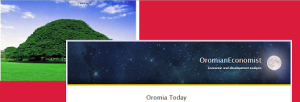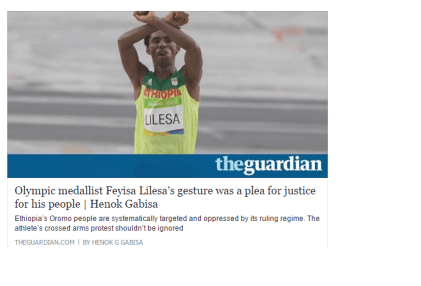When the Ethiopian Olympic marathon medallist Feyisa Lilesa crossed his arms at the finish line, the world asked what the symbol stood for. Little is known about the historical marginalisation and collective persecution of Lilesa’s people, the Oromo of north-east Africa.
Almost all Ethiopian runners come from the Oromia region; but the Ethiopian athletics federation is highly scornful of their Oromo identity. Perhaps the federation’s imperious attitude towards the athletes emanates from its paranoia and mistrust of the people, and fear that one day Oromo athletes might open Ethiopia’s Pandora’s box and spill the beans at an international sports event. Exactly what Lilesa did in Rio – and now he has not returned to Ethiopia.
At risk to his life, and at the sacrifice of his career, Lilesa was determined to express at the Olympics the collective grievances and institutional discrimination his people suffer in the Oromia region. The courageous crossing of his arms is a gesture of solidarity with the Oromo protest symbol that has been used over the last nine months in defiance of the ruling regime. In a short interview, Lelisa told what many believe is the story of the Oromo: the killings, the maimings, arbitrary detentions, profiling, enforced disappearances and economic injustices perpetrated by the Ethiopian government against the Oromo nation.
The current social and political crisis in Ethiopia was triggered by theAddis Ababa “master plan”, which was perceived by protesters as an attempt to remove the Oromo from the capital city. Even though it later dropped plans for this land grab, the regime claimed that its intention was to develop the city’s business district by further moving into the Oromo territories and neighbouring districts. No prior consultation, discussion or deliberation was had with the Oromo people, the ancestral owners of the land. Some saw this as being part of a grand scheme to ensure the long-term hegemony of the regime’s favoured ethnic group over the rest of the country. The Tigray, the regime’s dominant group, make up only 6% of the country’s population.
As Lilesa’s protest drew national attention, the situation in Ethiopia appeared to be deteriorating and having a serious impact on internal stability. It also cast a shadow of political uncertainty over the country.
Contemporary experiences teach us that economic and political inequality increases the risk of internal strife. When one ethnic group captures political power and excludes its perceived rivals, ethno-nationalist conflict is likely to increase, potentially descending into civil war. A heterogeneous society such as Ethiopia, where disparities in wealth overlap with ethnic grievances, is a good case study.
The scale of the Oromo protest over the last nine months has exposed Ethiopia’s ethnic-coded wealth distribution. According to Oxford University’s 2014Multidimensional Poverty Index (MPI), Ethiopia is the second poorest country in the world with about 58% living in acute destitution. Not all Ethiopians have benefited equally from the country’s economic growth.
The Oromia region, the nation’s agricultural breadbasket, is also the nation’s second poorest region in the federation. According to the 2014 MPI, about 90% of Oromo live in severe poverty and destitution, more than 80% of Oromo households do not have access to electricity or sanitation and more than 75% of Oromo do not have access to potable drinking water. Similarly, the UNDP’s 2014Human Development Index (HDI) placed Oromia well below the national average. Development in Ethiopia is not inclusive, not shared; many rural Ethiopians – the majority Oromo – remain in severe poverty. Oromo people are the most affected by the current drought and by the government’s response to it.
Economic inequality is echoed in the political realm. Amnesty International’s 2014 report, Because I am Oromo, chronicles targeting based on ethnic identity. Long before that, in June 2007, the UN committee on the elimination of racial discrimination had highlighted how Ethiopian military and police forces systematically targeted certain ethnic groups, in particular the Anuak and the Oromo peoples, and reported the summary executions, rape of women and girls, arbitrary detention, torture, humiliations and destruction of property and crops of members of those communities.
It is this marginalisation in the Oromia and Amhara regions that has forced the younger generation to protest in the streets, but the government response has been bloody. International human rights organisations report more than 500 lives were lost, but activists believe this figure could be more than 700. An estimated 20,000 or more people have been imprisoned, tens of thousands wounded and disappeared; many more rendered landless, homeless and jobless.
Now, with rallies taking place and with funerals in several corners of Oromia and Amhara lands, the conflict is likely to escalate and the country’s public security and stability to deteriorate. As reports continue to emerge, after several days of internet and social media blackout in the country, there is a growing fear that the regime has, knowingly or not, helped foment inter-ethnic conflict, pitting the Tigray against the Oromo and Amhara peoples. In fact, given the differences among ethnic groups, this could quickly descend into a large-scale conflict.
If there is any lesson the world can learn from Rwanda’s genocide, it is the pressing need to act as swiftly as possible to avoid this kind of worst-case scenario. Lilesa’s gesture is a request to the citizens of the world to stand with the Oromo in their quest for political and economic survival against the unjust face of Ethiopia. It is also a call for the western powers to re-evaluate their foreign policy towards Ethiopia and the Horn of Africa in the interests of real security, dignity, stability, peace and development for all the people – not a select few.




[…] The Guardian: Olympic medallist Feyisa Lilesa’s gesture was a plea for justice for his people. Click here to read at Oromian Economist, 24 August 2016 […]
Olympian’s family warn against return
https://www.yahoo.com/news/ethiopian-olympians-family-warn-against-081658574.html?soc_src=social-sh&soc_trk=tw
Feyisa Lelisa’s Olympic gesture is an appeal to global public conscience
http://linkis.com/edition.cnn.com/2016/oSVMK
[…] The Guardian: Olympic medallist Feyisa Lilesa’s gesture was a plea for justice for his people.Click here to read at Oromian Economist, 24 August 2016 […]